#dijon cathedral
Text

#dijon cathedral#dijon#dijon france#france#burgundy#french#church#gothic#architecture#historic#organ#pipe organ#church organ#gothic aesthetic#gothic architecture#gothic church#travel#romanesque#interior#building#structure#architectural photography#travel blog#travel photography#historic architecture#house of god#cathedrale#eglise#french architecture#worship
40 notes
·
View notes
Text

Crypt of the cathedral of Dijon, Burgundy region of France
French vintage postcard
#tarjeta#postkaart#cathedral#sepia#historic#france#photo#postal#briefkaart#crypt#photography#burgundy#vintage#ephemera#ansichtskarte#old#postcard#french#region#dijon#postkarte#carte postale
4 notes
·
View notes
Photo

Cathédrale Saint-Benigne, Dijon, Côte-d’Or, Bourgogne-Franche-Comté, France.
1 note
·
View note
Text
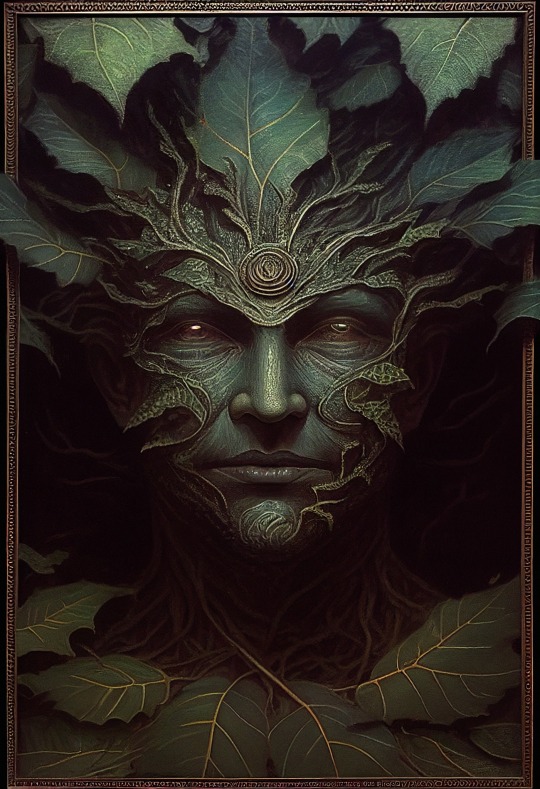
The Enigma of the Green Man
Symbol of life and nature:
The Celtic nature god Cernunnos from the Gundestrup Cauldron (1st Century BCE, now in the National Museum of Denmark in Copenhagen)
The Celtic nature god Cernunnos from the Gundestrup Cauldron (1st Century BCE, now in the National Museum of Denmark in Copenhagen)
The most common and perhaps obvious interpretation of the Green Man is that of a pagan nature spirit, a symbol of man’s reliance on and union with nature, a symbol of the underlying life-force, and of the renewed cycle of growth each spring. In this respect, it seems likely that he has evolved from older nature deities such as the Celtic Cernunnos and the Greek Pan and Dionysus.
Some have gone so far as to make the argument that the Green Man represents a male counterpart - or son or lover or guardian - to Gaia (or the Earth Mother, or Great Goddess), a figure which has appeared throughout history in almost all cultures. In the 16th Century Cathedral at St-Bertrand de Comminges in southern France, there is even an example of a representation of a winged Earth Mother apparently giving birth to a smiling Green Man.
Because by far the most common occurrences of the Green Man are stone and wood carvings in churches, chapels, abbeys and cathedrals in Europe (particularly in Britain and France), some have seen this as evidence of the vitality of pre-Christian traditions surviving alongside, and even within, the dominant Christian mainstream. Much has been made of the boldness with which the Green Man was exhibited in early Christian churches, often appearing over main doorways, and surprisingly often in close proximity to representations of the Christ figure.
Incorporating a Green Man into the design of a medieval church or cathedral may therefore be seen as a kind of small act of faith on the part of the carver that life and fresh crops will return to the soil each spring and that the harvest will be plentiful. Pre-Christian pagan traditions and superstitions, particularly those related to nature and trees, were still a significant influence in early medieval times, as exemplified by the planting of yew trees (a prominent pagan symbol) in churchyards, and the maintenance of ancient “sacred groves” of trees.
Tree worship goes back into the prehistory of many of the cultures that directly influenced the people of Western Europe, not least the Greco-Roman and the Celtic, which is no great surprise when one considers that much of the continent of Europe was covered with vast forests in antiquity. It is perhaps also understandable that there are concentrations of Green Men in the churches of regions where there were large stretches of relict forests in ancient times, such as in Devon and Somerset, Yorkshire and the Midlands in England. The human-like attributes of trees (trunk-body, branches-arms, twigs-fingers, sap-blood), as well as their strength, beauty and longevity, make them an obvious subject for ancient worship. The Green Man can be seen as a continuing symbol of such beliefs, in much the same way as the later May Day pageants of the Early Modern period, many of which were led by the related figure of Jack-in-the-Green.
Symbol of fertility:
Although the Green Man is most often associated with spring, May Day, etc, there are also several examples which exhibit a more autumnal cast to the figure. For example, some Green Men prominently incorporate pairs of acorns into their designs (there is a good example in King's College Chapel, Cambridge), a motif which clearly has no springtime associations. In the same way, hawthorn leaves frequently appear on English Green Men (such as the famous one at Sutton Benger), and they are often accompanied by autumn berries rather than spring flowers. The Green Man in the Chapelle de Bauffremont in Dijon (one of the few to retain its original paint coloration) shows quite clearly its leaves in their autumn colours.
This may have been simple artistic license. However, acorns, partly due to their shape, were also a common medieval fertility symbol, and hawthorn is another tree which was explicitly associated with sexuality, all of which perhaps suggests a stronger link with fertility, as well as with harvest-time.
Symbol of death and rebirth:
Green Man in the form of a skull on a gravestone in Shebbear, Devon, England (photo Simon Garbutt)
Green Man in the form of a skull on a gravestone in Shebbear, Devon, England
The disgorging Green Man, sprouting vegetation from his orifices, may also be seen as a memento mori, or a reminder of the death that await all men, as well as a Pagan representation of resurrection and rebirth, as new life naturally springs out of our human remains. The Greek and Roman god Dionysus/Bacchus, often suggested as an early precursor of the Green Man, was also associated with death and rebirth in his parallel guise as Okeanus.
Several of the ancient Celtic demigods, Bran the Blessed being one of the best known, become prophetic oracles once their heads had been cut off (another variant on the theme of death and resurrection) and, although these figures were not traditionally represented as decorated with leaves, there may be a link between them and the later stand-alone Green Man heads.
There are several examples of self-consciously skull-like Green Men, with vegetation sprouting from eye-sockets, although these are more likely to be found on tombstones than as decoration in churches (good examples can be seen at Shebbear and Black Torrington in Devon, England). Such images might be interpreted as either representing rebirth and resurrection (in that the new life is growing out of death), or they might represent death and corruption (with the leaves growing parasitically through the decaying body).
The Green Man by Talon Abraxas
40 notes
·
View notes
Photo
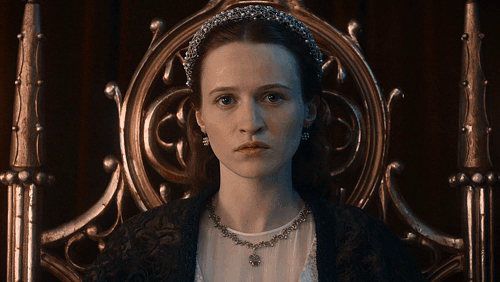




MARY OF BURGUNDY, THE RICH
Duchess of Burgundy, countess of Flanders, and archduchess of Austria, who fought to save her land from France and preserved what was to become the modern country of Belgium.
In Mary of Burgundy's days, Burgundy encompassed the area surrounding Dijon, Flanders, Picardy, and Brabant. It bordered France, Austria, and the English territories in the northeast part of continental Europe. The future of Burgundy was of utmost importance in the ongoing struggle for power between England and France, as well as in the many smaller conflicts throughout central and northern Europe. Mary's father, who was to be remembered as Charles the Bold, was the count of Charolois. Her grandfather, known as Philip the Good, reigned as the duke of Burgundy. Mary's mother was Isabelle of Bourbon , the second wife of Charles. His first wife Catherine de France had died young, with no children; Mary of Burgundy was therefore the sole heir to a large and rich territory.
Since Charles had no male heirs, potential marriages with Mary of Burgundy were plotted almost from the day of her birth on February 13,1457. Her entrance into the world was celebrated in a grand style, and her baptism at the cathedral of Coudenberg was considered "the greatest magnificence ever seen for a girl." This elegance may have been due to the political position of the child, or it simply may have been expected of the stylish House of Burgundy. Whatever the reason, the festivities lasted an entire day, and Louis of France, later to rule as King Louis XI, was appointed as Mary's godfather. Mary's grandmother, Isabella of Portugal (1397–1471), filled the role of godmother. Gifts were brought by representatives from across Europe, including some from a number of cities which were in rebellion against Duke Philip the Good at the time.
Mary of Burgundy spent most of her childhood at the ducal castle of Ten Waele at Ghent. She enjoyed an affectionate relationship with her father, even though he was almost constantly away from her. Especially after 1465, when Charles became the duke of Burgundy, he was personally involved in controlling and governing the cities of his territory. He also developed a flair for conquering new cities, and military operations kept him occupied for months at a time. Isabelle of Bourbon died when Mary was eight years old, and the girl was raised primarily by Lady Hallewijn, the wife of the duke's chief steward. Lady Hallewijn was a constant companion and loyal attendant to Mary throughout her life. Several cousins and other children from noble families lived with the heiress as playmates during her childhood. Mary's great-aunt (possibly Agnes of Burgundy) was responsible for arranging the series of governesses that educated the young lady. Not much is known about Mary's education, but it is clear that she could speak French, Flemish, and English. She enjoyed reading fables and Roman histories, and may have had some training in political philosophy. Her later actions as reigning duchess suggest that she was prepared early in life to govern.
Mary developed a keen interest in hunting, riding, and other outdoor sports, as well as in gardening. She cared for her falcons as if they were children; later in life, her husband would express surprise at Mary's insistence on keeping the birds in the bedroom, even within a few days of their wedding. Mary's personal seal was a picture of herself on horseback with a falcon on her wrist. She had a complete court of attendants from her infancy, including a dwarf named Madame de Beauregard.
Mary soon made her choice among the many suitors for her hand by selecting Archduke Maximilian of Austria, the future Holy Roman Emperor Maximilian I, who became her co-ruler. The marriage took place at Ghent on 19 August 1477, when she was 20 years old, while he was two years younger. Mary's marriage into the House of Habsburg initiated two centuries of contention between France and the Habsburgs, a struggle that climaxed with the War of the Spanish Succession bethween 1701 and 1714.
When they had time, the couple indulged themselves with dancing, hunting, music and the love for animals. Mary tried to teach him iceskating, which he struggled to master. They read romances together. Contrary to the custom of the time, Mary and Maximilian shared the same private quarters and bedroom. Mary nursed their children herself and used to dine with merchants from Dijon. She entusiastically cheered for her husband during tournaments, in which he exceled in jousting, not just in feats of strength but also in the luxury he lavished on the equipments, horses, accessories and ornaments. At first, they talked to each other in Latin. With Maximilian by her side, Mary's position became stronger, politically and militarily. Although he came with no money nor army, nor support from the Empire, and no prior experience in governance, his competence in military matters and his prestige as the son of an emperor boosted the stability of her territories. He took over the war effort, concerning both military and financial details.
In 1482, a falcon hunt in the woods near Wijnendale Castle was organised by Adolph of Cleves, Lord of Ravenstein, who lived in the castle. Mary loved riding and was hunting with Maximilian and knights of the court when her horse tripped, threw her in a ditch, and then landed on top of her, breaking her back. She died several weeks later on 27 March from internal injuries, having made a detailed will. She was buried in the Church of Our Lady in Bruges on 3 April 1482. She was pregnant at the time.
Maximilian was devastated. She had initially hidden the extent of her injury to calm him down. When he continued to display uncontrollable grief, she had to force him out of her chamber so that she could discuss matters of the state with her vassals, concerning which she asked them to keep their loyalty oath to him and their children. Maximilian was not present when she said her last words.
#mary of burgundy#house of habsburg#habsburg#maryandmaximilliam#duchyofburgundy#historicalwomen#history#european history#royal women
29 notes
·
View notes
Text
Attacks against churches and anti-Christian violence reach record levels in Europe in 2019, yet continue to target magnificent Christian landmarks to this day
“France has been one of the great nations marked by the Christian faith since the dawn of history; and after the fall of the Roman Empire, it was the first nation of the West to declare itself the daughter of the Church, the “eldest daughter of the Church”. For centuries, France made a special contribution to the Catholic Church through the enlightened and heroic testimony of her saints, the doctrinal power of her masters, and the apostolic courage of missionaries …”John Paul II, Fiumicino, May 30, 1980 before the departure to Paris.
Sadly, France has recently experienced a wave of vandalism against Catholic churches, including burning and sacrilege.
Vandals have destroyed crosses, knocked down tabernacles, scattered or destroyed the Eucharist, and broken statues, raising concerns that anti-Catholic sentiment is on the rise in the nation. The french interior ministry said , "there were 878 attacks on Christian buildings and cemeteries, including 252 in cemeteries, and 626 on places of worship in 2017."
Just than 1,000 incidents of vandalism against Christian structures and cemeteries were documented in France in 2018 alone.
"One religious building is disappearing in France every two weeks."
That is the conclusion of Edouard de Lamaze, president of the Observatoire du patrimoine religieux (Observatory of Religious Heritage) in Paris.
The historic Church of St. Sulpice in Paris was burned down on Sunday, March 17, 2019, shortly after noontime mass.The French Interior Ministry recorded 996 anti-Christian acts in 2019, an average of 2.7 per day.
Just a smattering of recent church attacks in France include:
· The fire which devastated St Paul in Corbeil-Essonnes in July 2020;
· The vandalism of Notre-Dame, Dijon, in February 2019;
· The arson attack at Notre-Dame de Grâce in Eyguières, Provence, on Easter Sunday 2019;
· The desecrating of the tabernacle of Saint-Pierre in Montluçon, Auvergne, in April 2019;
· The burning to the ground of Saint-Jacques in Grenoble, Rhone-Alpes, in January 2019;
· The arson attack at Saint-Pierre du Matroi in Orléans, with ‘Allahu akbar’ scrawled on its surviving walls in July 2018;
· The vandalism of the holy font and placing of the Koran beside the chopped-off arm of a broken statue by a Syrian woman with an axe at Sainte-Marie-Madeleine, Vézelay, in April 2017.
In a rare candid moment, German media reported at least 200 cases of damaged churches in the region of Bavaria alone every year.
Edouard de Lamaze, president of the Observatoire du patrimoine religieux (Observatory of Religious Heritage) in Paris, explained that only 15,000 Catholic sites are officially protected as historical monuments, while the other 30,000 buildings are practically left to decay.
A structural fire started in the cathedral's roof area on April 15, 2019, just before 18:20 CEST. Notre-Dame de Paris is a historic Catholic church located in Paris, France. The cathedral's spire had fallen, the majority of its roof had been destroyed, and its upper walls had been seriously damaged by the time the fire had been put out.
The blaze at Notre-Dame de Paris in 2019 was preceded by a fire at the Cathedral Saint-Alain of Lavaur in Tarn, southern France, and followed by fires at the cathedrals of Rennes and Nantes in 2020.
7th of July 2023 In Drosnay, in the North-Eastern area of France, as new violence has erupted in the nation, a 16th-century church was attacked and set ablaze. There is a video available that shows the church being completely destroyed by fire. Police believe this may have been a protest against the teen's death at the hands of a police officer in Paris.
Sources:
5 notes
·
View notes
Photo
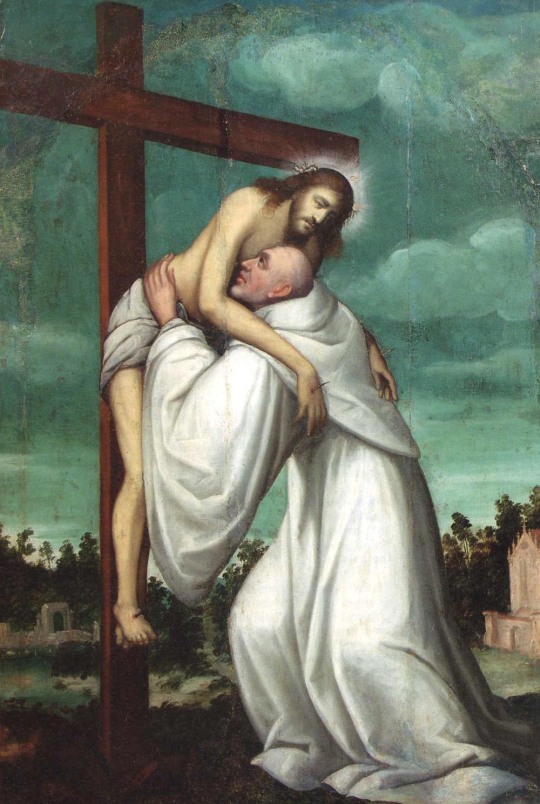
THE DESCRIPTION OF SAINT BERNARD OF CLAIRVAUX
Feast Day: August 20
"God will either give us what we ask, or what He knows to be better for us."
The abbot of Clairvaux, confessor, the Last of the Fathers, the Doctor Mellifluus, and a Doctor of the Church, was born of a noble family at Fontaine-lès-Dijon, Burgundy, Kingdom of France in 1090. Bernard was the third of seven children, and his parents were Tescelin de Fontaine, lord of Fontaine-lès-Dijon, and Alèthe de Montbard, both members of the highest nobility of Burgundy. At the age of 9, he was sent to a school at Châtillon-sur-Seine run by the secular canons of Saint-Vorles, and had an interest in literature and rhetoric. He had a special devotion to the Virgin Mary, and he later wrote several works about the Queen of Heaven. At 19, he lost his mother, and during his youth, he did not escape trying temptations and around this time he thought of living a life of solitude and prayer. At the age of 22, while he was at prayer in a church, he felt the calling of God to enter the Cistercian Monks of Cîteaux.
His testimony was so irresistible that 30 of his friends, brothers and relative followed him into monastic life. Three years later, Bernard was sent with 12 monks to found a new monastery at Clairvaux, a forested place in the Valley of Wormwood. The reputation of his holiness soon attracted 130 new monks, including his own father. During the absence of the Bishop of Langres, Bernard was blessed as abbot by William of Champeaux, Bishop of Châlons-sur-Marne. From then on a strong friendship grew between the abbot and the bishop, who was professor of theology at Notre Dame of Paris and the founder of St. Victor Abbey in Paris.
One day in order to cool down his lustful temptation, he threw himself into ice-cold water. Another time, while sleeping in an inn, a prostitute was introduced naked beside him, and he saved his chastity by running. Many miracles were attributed to his intercession. One time, he restored the power of speech to an old man that he might confess his sins before he died. Another time, an immense number of flies, that infested the Church of Foigny, died instantly after the excommunication he made on them. So great was his reputation that Princes and Popes sought his advice, and even the enemies of the Church admired his holiness of his life and the greatness of his writings. Bernard then passed into Germany, and the reported miracles which multiplied almost at his every step undoubtedly contributed to the success of his mission. Conrad III of Germany and his nephew, the future Holy Roman Emperor, Frederick Barbarossa, received the cross from the hand of Bernard.
In 1128, Bernard participated in the Council of Troyes, which had been convoked by Pope Honorius II, and was presided over by Cardinal Matthew of Albano. The purpose of this council was to settle certain disputes of the bishops of Paris, and regulate other matters of the Church of France. The bishops made Bernard secretary of the council, and charged him with drawing up the synodal statutes. After the council, the bishop of Verdun was deposed. It was at this council that Bernard composed a rule for the Knights Templar; it soon became an ideal of Christian nobility. Around this time, he praised them in his 'Liber ad milites templi de laude novae militiae (Book to the Knights of the Temple, in praise of the new knighthood)'.
In 1144, Bernard was commissioned by Pope Eugene III to preach the Second Crusade. Moved by his burning words, many Christians embarked for the Holy Land, but the Crusade ended in total miserable failure. That proved that even saints sometimes can commit mistakes. He died on August 20, 1153 at the age of 62 or 63, in Clairvaux Abbey in the province of Champagne (modern day part of Ville-sous-la-Ferté).
Canonized a saint by Pope Alexander III on January 18, 1174 and declared a Doctor of the Church by Pope Pius VIII in 1830, his major shrine can be found at the famed Troyes Cathedral (Cathédrale Saint-Pierre-et-Saint-Paul), where his 12th century reliquary is held. Bernard is the patron saint of candlemakers, beekeepers, and the Poor Fellow-Soldiers of Christ and of the Temple of Solomon aka the Knights Templar.
11 notes
·
View notes
Text
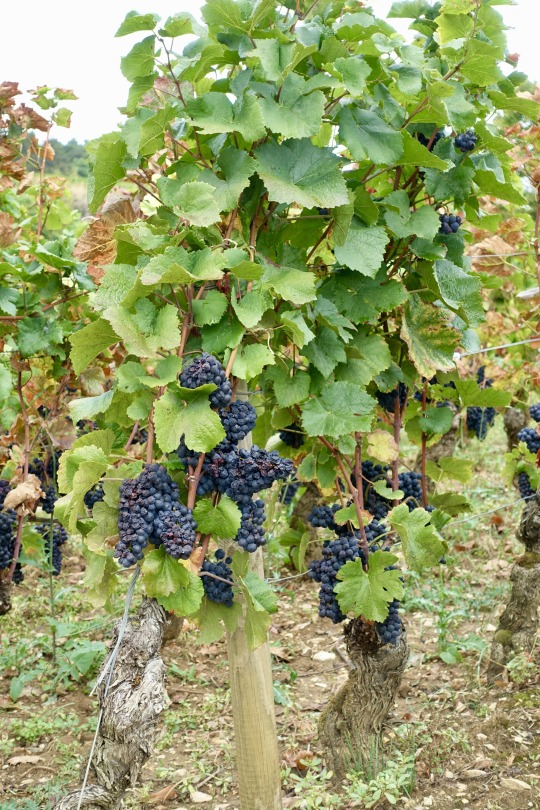
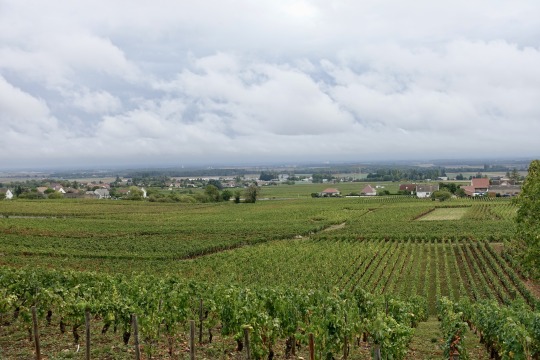
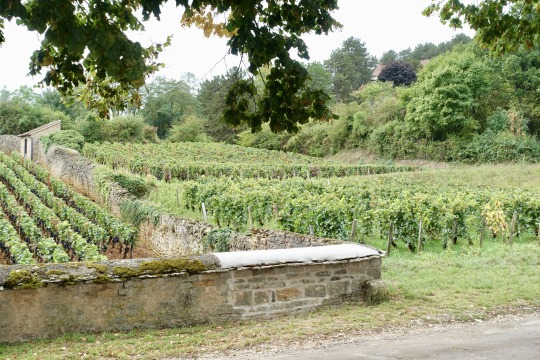

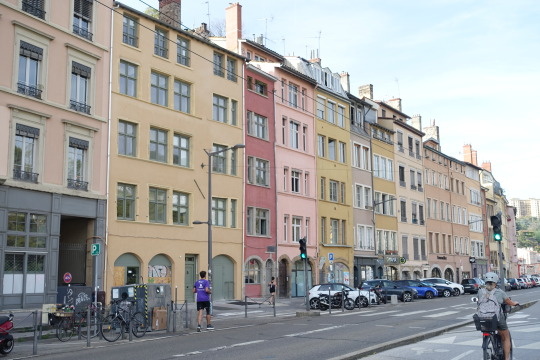
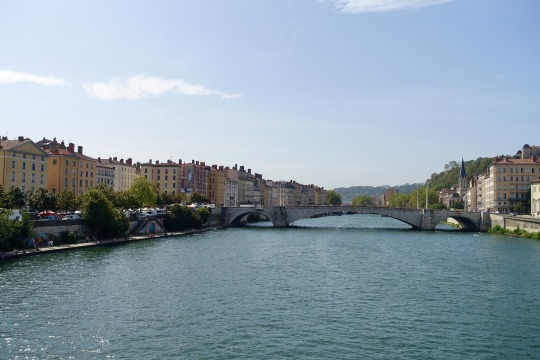

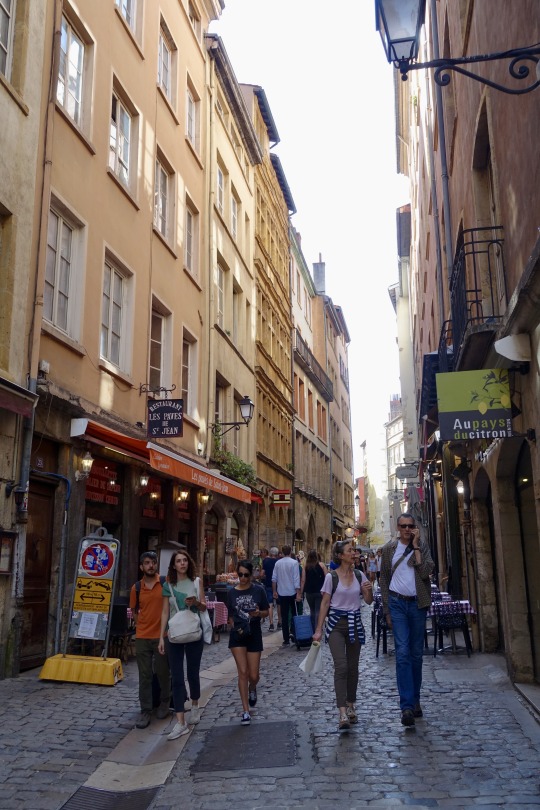
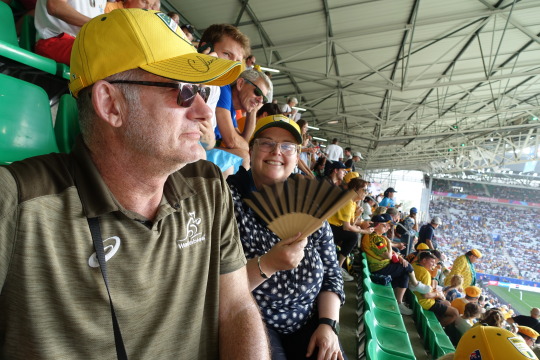

Route des Grands Crus & Australia VS Fiji
(Entry by Elena)
Today we said goodbye to beautiful Dijon which has been our favourite stop by far. Croissants for breakfast were a must from the best bakery we’ve visited this trip, and then it was off to Lyon we went. The drive was through the Burgundy wine region which was exciting, so we decided to follow the Route des Grands Crus which is a relaxing drive through French wine villages and vineyards. We were super lucky and many of the vineyards were actually harvesting; we drove past lots of trucks full of grapes which was very cool. The views and villages we drove past were also stunning. This part of France has been a wine making region for hundreds of years so many of the vineyards are on the UNESCO World Heritage list. Everything was so green and lush and it ended up being a gorgeous drive into Lyon.
Lyon was slightly disappointing which is definitely not the city’s fault (it actually looks quite pretty here, like a mini Paris!). The city is absolutely chockers with Aussies and Kiwis as our Rugby teams are based here, so accommodation was tough to get and we’ve ended up in a very run down outskirt area of town. It’s a little sketchy to say the least and transport is hard into the more picturesque centre of town. We’re spending the rest of our trip here, 10 days, so our expectation of Lyon was to do lots of relaxing and wandering around which might be hard here… So stay tuned for some possible crisis management by our fearless leader (the famed Kylie Bryant).
Even though the accommodation isn’t great, Lyon is a lovely city. Our first morning here we drove into the old town which is unreal; the area is actually one of Europe’s most extensive Renaissance neighbourhoods. We walked around and visited some markets and gorgeous cathedrals. Classic ancient French city vibes! Then we headed home early as there’s another Australia game tonight! I didn’t go to this one so it was a boring evening at the Airbnb for me, and another exciting game for Lachlan and his parents.
(Entry by Lachlan)
So. That happened. Fiji upset Australia to convincingly win and create one of the most notable games of the tournament. The stadium and the atmosphere was amazing - the seats are arranged very steeply so you feel so close to the game, and the acoustics made the 40,000 people feel intimate and amplified. The game was exciting and we got to scream and shout with the Aussie crowd around us (with the added edge that Fiji were getting the better of us). At the end when Fiji won it was clear how much it meant to them and to the fans, they hugged each other and many prayed and cried - it was amazing to be there for such a moment for their team. They haven’t beaten Australia since something like 1972, and it opens up the opportunity for them to make it to their first quarter final. So it's hard to be mad. We then made our way home via a random dirt-road detour, and had some ice creams and watched another game of rugby on the couch.
1 note
·
View note
Text
Tue August 8
After coffee from the hotel bar and some leftovers from dinner, we walked to the Fourvière Basilique for another look. It’s still sumptuous and and over the top ornate with sculptures, mosaic walls and ceilings. Still gorgeous, of course, even the crypt / lower level, which is a church in its own right. On the walk down to the Old City we tried and failed to find the Roman ruins & amphitheater. We peeked at the old Cathedrale- beautiful but not as much as some of the Cathedrals and churches we saw in Reims, Strasbourg and Dijon. It’s all a matter of perspective. We had a reservation for lunch at a restaurant (L’inaTTendu) that was ~2 miles from the Old City, across both rivers (Saône and Rhône). Lunch was good (esp dessert) and as we were already a bit tired, we took an Uber back to the Saône River pedestrian bridge. Looked around the Old City a bit more, and then took the fenicular back up to our neighborhood. Had the last glasses of last evening’s Beaujolais along with cheese, copa and bread.
0 notes
Text
Saturday 28 June 1834
5 50
10 55
with her from ten to eleven and a quarter and a long very good kiss to her and tolerable to me - fine morning F57 ½° at 6 10 - breakfast at 7 ¼ - wrote the last 15 lines till 8 ¾ - Hotel le la cloche very comfortable – good eating – attent[ive] civil people - Miss W- and I out at 9 ¼- cathedral good old gothic church but not so handsome as Notre Dame we saw last night - at the botanic garden at 9 40 called Jardin des plantes – the old one given up and this new one not quite finished - approached thro’ a piece of nicely laid out, wooded (with large trees) piece of ground in which boys were playing and seeming to belong to a good pile of brick building adjoining the garden - perhaps (from the no. of beds in a room) a school - much pleased with the garden – only wish it larger – (or square of about 3 or 4 acres?) all the trees, shrubs and flowers planted quite recently - a winding stream all thro’ (across from corner to corner) with a little basin and boat on it - 2 or 3 pieces of pretty rock-made mount, and a gothic seat hide the ends of wall, too little distant as one faces it on entering - small but pretty serres near the top of the garden, nicely placed the right side wall on entering - flower beds (as at the Jardin des plantes Paris) laid out in narrow stripes, but looking more soignés from being all box-edged and having 2 ft gavel walks between - all the plants ticketed (Linnaean system?) Sambucus nigra common Elder - Fedia (forget-me-not?) Dipsacus, teazle - cineraria maritima (while velvety stalks and leaves ragged, like senecio, dogstander) - Off from the hotel de la cloche (very comfortable - good eating) Dijon at 10 47 D- a very nice good provincial town, in a fine country - Genlis (1st relais) very neat little village - Auxonne fortified goodish town – stopt on entering the poste de ville to shew passports and at the café opposite for a cafe au lait for A- had it in 22 minutes – walked forwards to the poste and off in 2 minutes more at 2 18 - soon after Dijon on getting to the top of the 1st rising ground 1st view of a saddle-backed mountain of the Jura range - wide, fertile plain (common India ditto 1st we have seen potatoes lucerne grass etc) around Dijon and all the way till the wooded hills en face gradually closing upon us on nearing Dôle [Dole] till at 3 40 from the top of the hill (or mountain?) just above Dôle [Dole], very fine rich view - a large vine-covered sufficiently wooded plain to our right, Auxonne behind us, and the good-looking town of Dôle [Dole] with its church steeples en face backed by the long line of Jura mountains - not like Alps or Pyrenees, but very fine - vines for the last hour (from about 2 40) and all about Dôle [Dole] in the rich plain, little else - at Dôle [Dole] at 4 11 – no postilion - obliged to wait - so drove to the hotel de Paris close by – dined (very good dinner) at 5 in an hour - before and after 6 ¼ wrote the above of today - off from Dôle [Dole] at 6 22 – no vines much beyond D- - corn India ditto, hemp etc as before - the Jura not more than the wolds ½ way between York and Market Weighton now at 8 ¼ - picturesque villages all today - at la Poste Mont-sous-Vaudrey at 8 35 – a mere auberge - but a nice enough double bedded room and wanting nor dinner or breakfast in the morning (both which by the way would I daresay have been very fair) we do very well - some little more than usual difficulty in bargaining for the 4 beds for 6/. - fine morning, tho’ blackish clouds about soon after 12, and showers in the afternoon, but fair and fine from between 4 and 5 for the rest of the evening - F68° at 9 pm.
0 notes
Text

Interior of the Cathedral in Dijon, Burgundy region of France
French vintage postcard
#historic#briefkaart#postkaart#burgundy#carte postale#ephemera#tarjeta#photo#dijon#france#postcard#postal#interior#cathedral#postkarte#region#ansichtskarte#french#sepia#photography#vintage
1 note
·
View note
Photo

Traxsource New Techno Tracks 2022-06-27
DOWNLOAD: https://thedjmusic.com/music/traxsource_new_techno_tracks_2022_06_270
DATA CREATED: 2022-06-27 TOTAL: 120 GENRE: Techno, Melodic House & Techno, Hard Techno, Electronica
Acid Jerks - The Tribute (Extended Mix)
Adapter - Skate Dancer
Alan Dixon - Night Time Melodies
Ash Lauryn - Life Is Back
Austin Ato - Tony
Avant Garde - Perpetuity 1 (Extended Mix)
Belcampo - Your Kissing (feat. Elisabeth Troy)
Billy Lo - It's the Life
Blaze - Do You Remember House? (feat. Palmer Brown) [Harry Romero Extended Remix]
Bruise - Joy
Bruise - When Pianos Attack
Cakes da Killa & Proper Villains - Don Dada (Honey Dijon & Luke Solomon's Extended Alcazar Remix)
Charles Webster - The Spell (feat. Ingrid Chavez)
Cioz - Rain
Clive From Accounts - Without Your Love
COEO - I Can Never Be Yours
Crackazat - Alfa
D.C. LaRue - Cathedrals (Faith's Farley & Jarvis Extended Sunday Sermon Mix)
Dam Swindle - Spice Run
Dames Brown - What Would You Do? (feat. Amp Fiddler & Andrés) [Expansions NYC Dub Vocal]
Dan Curtin - Soul System
Darran Nugent & Life on Planets - Thought Waves (Extended Deep Vocal Mix)
Dave + Sam - Facts (Jovonn Extended Remix)
Dave + Sam - Sauce (Manoo Buzzin Extended Vocal)
David Morales - The Feels (feat. Mr. V, DJ Rae & Scott Paynter) [Extended Mix]
David Morales & Mr. V - Everyday of My Life (Vocal Mix)
David Morales & Timmy Regisford - Maka (feat. Toshi) [David Morales DIRIDIM Mix]
Dennis Ferrer - Sunny Days (with Dawn Tallman) [Extended Mix]
Dimitri from Paris & Fiorious - Music Saved My Life (Marshall Jefferson Extended Remix)
Diogo Strausz - Emancipação (Ron Trent Remix)
DJ Deep - Vaincre
DJ Holographic - Faith in My Cup (Detroit Love Mix) [feat. Apropos] [Mixed]
DJ Oji - Cranes In The Sky (feat. Tracy Hamlin)
DJ Spen & Soulfuledge - Goin' Home (To See My Savior) [Kerri Chandler Radio Edit]
Double Exposure - Everyman (Dam Swindle Remix)
Doug Gomez - Celestial Dance (feat. Benjy)
Fatima Njai & Jerome Sydenham - In the Pocket
Felipe Gordon - Strings of the Afterlife
Felipe Gordon & Kai Alce - Evolving Textures (Kai Alce Interpretation)
Fényan & Kosmo Kint - Break Your Rules
Floorplan - Right There (Extended Mix)
Floorplan - Save the Children
Gianluca Pegoiani - Numero 5 (Rough Ride) [feat. Ann Saunderson] [Original Vocal Cut]
Guillaume & The Coutu Dumonts - The Chase (feat. Dave Aju) [Extended Remix]
Hanna - Champion
Hazy James - Need Somebody (Hardway Bros Remix)
Honey Dijon - Downtown (feat. Annette Bowen & Nikki-O) [Louie Vega Extended Raw Dub Mix]
Horse Meat Disco - Message To The People (feat. Amy Douglas & Dames Brown) [Danny Krivit XL Edit]
Ian Pooley - Basic Juno
IWDG - In a Lonely Place
Jacques Renault - My Left Foot
Jaden Thompson - Closer (Derrick Carter Remix)
Jazzanova - Creative Musicians (feat. Sean Haefeli) [Waajeed Remix]
Jimpster - Soul Spectral (feat. Greg Paulus)
Jimpster & Rich Medina - This Thing (Vocal Mix)
Joaquin Joe Claussell - You Mutha Fuka
Joe Ventura - Salsa House Revisited (Fist Pump To The Tunnel Mix)
Jordan GCZ - Jaguar Dreamin
Jovonn - Random (Extended Mix)
Jungle Fire - La Kossa (JKriv Elektrikossa Dub)
Kameelah Waheed - America the Beautiful (North Street West Vocal Remix)
Lady Blackbird - Beware The Stranger (Ashley Beedle's 'North Street West' Vocal Remix)
Lady Blackbird - Lost and Looking (Colleen 'Cosmo' Murphy Cosmodelica Remix) [Edit]
LadyMonix - Steppin' Out (Waajeed's Get Into It Girl Dub)
Lazarusman - Here We Are
LDLDN - Make Time
LDLDN - Theodore's Gift
Lea Lisa - Keys of Life (Gu's Esoteric Chicago Mix)
Lore of the Samurai - City Loop
MAN POWER - Cepheid Variable, Pt. 2
MAN POWER - Flashing Lights (feat. Amy Douglas)
Marina Trench - Sunrise
Midnight Magic - Beam Me Up (Kim Ann Foxman's Beam Me to the Basement Mix)
Miguel Migs - Sensations (feat. Andy Allo) [Miguel Migs Deep Feels Extended Vocal]
Mike Nasty - Breakthrough
Milton Jackson - Remember
Moe Taha - No One (Extended Mix)
Moondance - Never Found Love (Amen Mix)
Mr. Bard & DJ Steef - Ritual of the Body (Craig Smith Drum Talk Mix)
Nicola Conte & Gianluca Petrella - Inner Light Joe Claussell Sacred Rhythm (Cosmic Arts Dub Version)
Opolopo - In the Fast Lane
Orlando Voorn - Everyday Desires (Will's Super Culture Remix)
Radio Slave - Live My Life
Raf Rundell - Always Fly (feat. Terri Walker) [Bruise Remix]
Retromigration - Free Spirit
Rocco Rodamaal & Osunlade - Tbt3 (Osunlade Remix)
Sentimental Animals, JKriv & Dicky Trisco - Love Vibration (7" Disco Mix) [feat. Nicki B the Vagabond]
Session Victim - Guidance
Shiba San - Let's Go Dancing
Solid Gold Playaz - The Kiss
Soul of Hex - Dreams
Spencer Parker - Beat U
Spencer Parker - Dream the Future
Steffi - Reasons (feat. Virginia)
Steve Bug & Cle - Let It Go
Stinger J. - Pretty Face (12" Version)
Stubb - We Are Launching (feat. Jane Weaver)
Surprise Chef - Crayfish Caper (Nuyorican Broken Mix)
Talaboman - Dins El Llit (Superpitcher Remix)
The Royal Academy Of Fierce, Larry Tee & Radio Slave - Black Pussy’s Revenge (feat. Tobell Von Cartier)
The Spaces Between - Ghosts (feat. Harry Dennis) [Black Science Orchestra Remix #1]
Trittico - Forma Prima
U - Ecstasy
yone-ko - A Downpour of Blessings
Zeitgeist Freedom Energy Exchange - Kreuzberg Kix
Zepherin Saint - Elegua - The Opener (feat. Amma Whatt) [Tribe Vocal Mix]
1 note
·
View note
Photo

Dijon Cathedral
#Dijon#France#Cathedral#Church#Europe#European#Travel#Architecture#Landmark#Historic#Beautiful#French
9 notes
·
View notes
Text
Père’s Unfulfilled Wish
Brigitte exhaled as she came upon the Cathédrale Saint-Bénigne.
Pensively she said, “Père would have been tearful. He carried painful memories of the war in his heart.”
“Henri, why did you die before you could find peace?”
Mère had never spoken about those times, nor did Père
After the funeral, I promised Mère I’d bring her here. Now, she’d find peace for both of them.
As I looked at the…

View On WordPress
#cathedral#CrispinasCreativeChallenge#FrenchRevolution#life#memories#photography#Saint-Benigne#war#writing#Cathédrale Saint-Bénigne de Dijon
0 notes
Note
What French cities would be better to visit as a tourist than Paris?
If you're after cities specifically then:
Strasbourg
Heart of the Alsatian region. The cathedral has an impressive astronomical clock and its accompanying automatons are in a museum across the street. Lots of half-timber buildings! Not as hot as the south and the 3rd largest city. Not too big, not too small, and you can actually afford it! x) There's also plenty to see within a short travel distance via trams and regional trains! Totally biased, but there’s a museum in Bouxwiller on Jewish history in the region if anyone is interested. If you want to plan a holiday trip Strasbourg has the oldest Christmas market in France and one of the largest in Europe too!

Lyon
2nd largest city. Still affordable. I lived here for 4 years and loved it. (still bummed we moved sometimes) The gastronomic capital of the world since 1935 so if you like food/cooking this the place to be! Plenty to do and surprisingly LGBTQ+ friendly too. The Musée Cinéma et Miniature is a must! They've got costumes, sets, and props from a lot of famous movies! It also fairly quiet at night compared to other cities I've been in. If you’re there during the winter The Fête des Lumières happens on the 8th of Dec and is pretty fun. It’s a chill night out. You can also extend your trip out to places like Grenoble and Vienne, Isère. Vienne my spouse and I can personally attest to. It's not expensive and there's a whole litany of Roman ruins to see!
Montpellier
Coastal town in the French Catalan region! It's not as crazy as Marseille, Toulouse, or Nice and there's a ton you can do. The city has huge Aquarium and a really nice Zoological Park if you like critters! You can also go diving or boating. If you don't mind traveling to places nearby you can extend your trip to places like Carcassonne, an extremely tourist friendly medieval fortified city. I went a few summers ago and it was incredible. I had an absolute blast!

Dijon (yes like the mustard) If you like nature, sight-seeing, and/or wine then this is the place for you! They offer a ton of bike tours around the city and the local vineyards. There is wine everywhere. I would recommend trying to visit Guédelon if you're in the region and love medieval history! It's a medieval castle that's currently being constructed using only period accurate tools and materials. Very cool.
Brest or Nantes
Both are large cities in the Brittany region of France. I'm not sure if you'll find a lot of the Breton language around these places (I've been told you can), but there's still plenty to do. Brest has a naval history museum and an awesome aquarium. Nantes has a lot of museums including Machines de l'Île which is more like smashing a museum with a theme park.

You'll probably recognize this guy from videos online. Yes, you can ride it and yes it sprays water so bring a poncho if you wanna stay dry! There's a ton of cool things here to see. If you love robots or animatronics this one is a must!
Mont Saint-Michel
Not exactly a city in the traditional sense, but it's worth it. Access literally changes with the tides and high tide is probably the most gorgeous time to visit. It's a lot like Carcassonne. There's plenty to do within the city itself and it tends to be very tourist friendly. When the tide is low enough you can go outside the city and walk around on the sand, but if you do keep and eye out for quicksand.

Hope this helps! :)
#sheep.txt#answers#travel#france#strasbourg#lyon#montpellier#carcassonne#dijon#brest#nantes#mont saint michel
178 notes
·
View notes